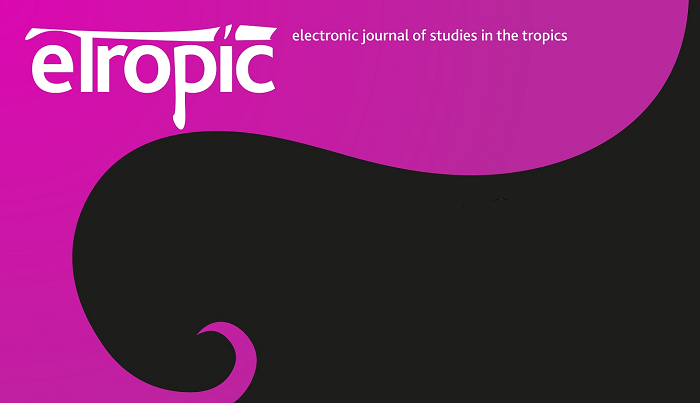The “Post-Quantal Garden” Annotated
DOI:
https://doi.org/10.25120/etropic.20.2.2021.3817Keywords:
speculative fiction, cli-fi, JG Ballard, Marshall Islands, climate change, bio-hacking, Chthulucene, nuclear testing, tropical imaginaryAbstract
The Post-Quantal Garden is a work of speculative fiction based on J.G. Ballard’s short story “The Terminal Beach” first published in 1964. Set within Donna Haraway’s climate-changed Chthulucene, the work is intended as an elliptical rumination on the history of nuclear testing in the Pacific, bio-hacking, tropicality, and apocalyptic narrative. Moving between historical fact and speculative fiction, the story takes the form of a scholarly introduction to and contextualization of fictional passages from an imaginary journal supposedly found during the very real radiological clean-up of Enewetak Atoll. Enewetak, an atoll in the Marshall Islands group, was used by the US for nuclear testing and was the site of operation Ivy-Mike, the first fusion bomb test, and is the setting for Ballard’s Terminal Beach.
References
Alik, A. (2070) Infinite in all Directions. Palgrave Otomo.
Ballard, J.B. (1964). The Terminal Beach. Gollancz.
Haraway, D. (2015). Anthropocene, Capitalocene, Plantationocene, Chthulucene: Making Kin. Environmental Humanities 6, 159-165. https://doi.org/10.1215/22011919-3615934 DOI: https://doi.org/10.1215/22011919-3615934
Lovecraft, H.P. (1928) The Call of Cthulhu. Weird Tales, 11(2), 159-178 (287).
Okung, Berman and Ling (2072) From Alik to Moreau, Questioning the giants of the Biological Age. Biology and Culture, 17(2), 9-37.
Shelley, M. & Bowers, H.P. (2073) Religion in the Chthulucene: Science, myth and the quest for meaning in an uncertain age. University of New California Press.
Special Correspondence (1905, 15 October). Failure of a Womanless Eden in the Pacific – Strange Story from the South Seas The New York Times. https://www.nytimes.com/1905/10/15/archives/failure-of-a-womanless-eden-in-the-pacifica-strange-story-from-the.html
Downloads
Published
How to Cite
Issue
Section
License
Copyright (c) 2021 CC-BY

This work is licensed under a Creative Commons Attribution 4.0 International License.
Authors who submit articles to this journal agree to the following terms:
1. Authors are responsible for ensuring that any material that has influenced the research or writing has been properly cited and credited both in the text and in the Reference List (Bibliography). Contributors are responsible for gaining copyright clearance on figures, photographs or lengthy quotes used in their manuscript that have been published elsewhere.
2. Authors retain copyright and grant the journal right of first publication with the work simultaneously licensed under a Creative Commons Attribution (CC-BY) License that allows others to share and adapt the work with an acknowledgement of the work's authorship and initial publication in this journal.
3. Authors are able to enter into separate, additional contractual arrangements for the non-exclusive distribution of the journal's published version of the work (e.g., post it to an institutional repository, or publish it in a book), with proper acknowledgement of the work's initial publication in this journal.
4. Authors are permitted and encouraged to post their work online (e.g., in institutional repositories or on their website) prior to and during the submission process, as it can lead to productive exchanges, as well as earlier and greater citation of published work (see The Effect of Open Access or The Open Access Citation Advantage). Where authors include such a work in an institutional repository or on their website (i.e., a copy of a work which has been published in eTropic, or a pre-print or post-print version of that work), we request that they include a statement that acknowledges the eTropic publication including the name of the journal, the volume number and a web-link to the journal item.
5. Authors should be aware that the Creative Commons Attribution (CC-BY) License permits readers to share (copy and redistribute the work in any medium or format) and adapt (remix, transform, and build upon the work) for any purpose, even commercially, provided they also give appropriate credit to the work, provide a link to the license, and indicate if changes were made. They may do these things in any reasonable manner, but not in any way that suggests you or your publisher endorses their use.
